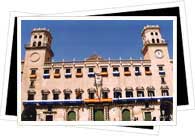 Following the Gothic era came the celebrated Renaissance, an important intellectual, artistic and architectural movement of the 15th and 16th centuries that originated in Italy and later spread throughout Europe. The architectural portion of the movement sought to bring back the symmetrical and proportionally flawless architecture of ancient Rome. Columns, classic shapes and overall extreme order replaced the exaggerated heights and structures characteristic of the Gothic period.
Following the Gothic era came the celebrated Renaissance, an important intellectual, artistic and architectural movement of the 15th and 16th centuries that originated in Italy and later spread throughout Europe. The architectural portion of the movement sought to bring back the symmetrical and proportionally flawless architecture of ancient Rome. Columns, classic shapes and overall extreme order replaced the exaggerated heights and structures characteristic of the Gothic period.
Plateresque
In Spain, Renaissance architecture manifested itself in two vastly different manners: Plateresque and Herrera style (escorialense). As Spain, during this "Siglo de Oro" (Golden Century), was experiencing quite the plethora of financial benefits following a certain rather famous overseas discovery, it's only natural that at least some of the architecture reflect its affluency. With tons of intricate work and hoards of shiny gold and silver, the Plateresque style was almost like flashy, over-the-top Gothic.
Herrera Style / Escorialense
The juxtaposing Herrera style is everything that Plateresque is not. The Herrera style, as the name implies, was protagonized by the architect Juan de Herrera, who built the enormous Escorial- a combination monastery, seminary, palace and basilica. Perfect symmetry, total lack of decoration, extreme austerity and absolutely enormous proportions- the Escorial, for example, is the largest building in Spain- are distinguishing characteristics of this second architectural branch of the Spanish Renaissance.
In Alicante, the Concatedral de San Nicolás, the city's cathedral, is the epitome of the Herrera style. Designed and built by a student of Herrera between 1616 and 1662, you can easily see that the somber cathedral boasts all of the characteristic Herrera-style elements.